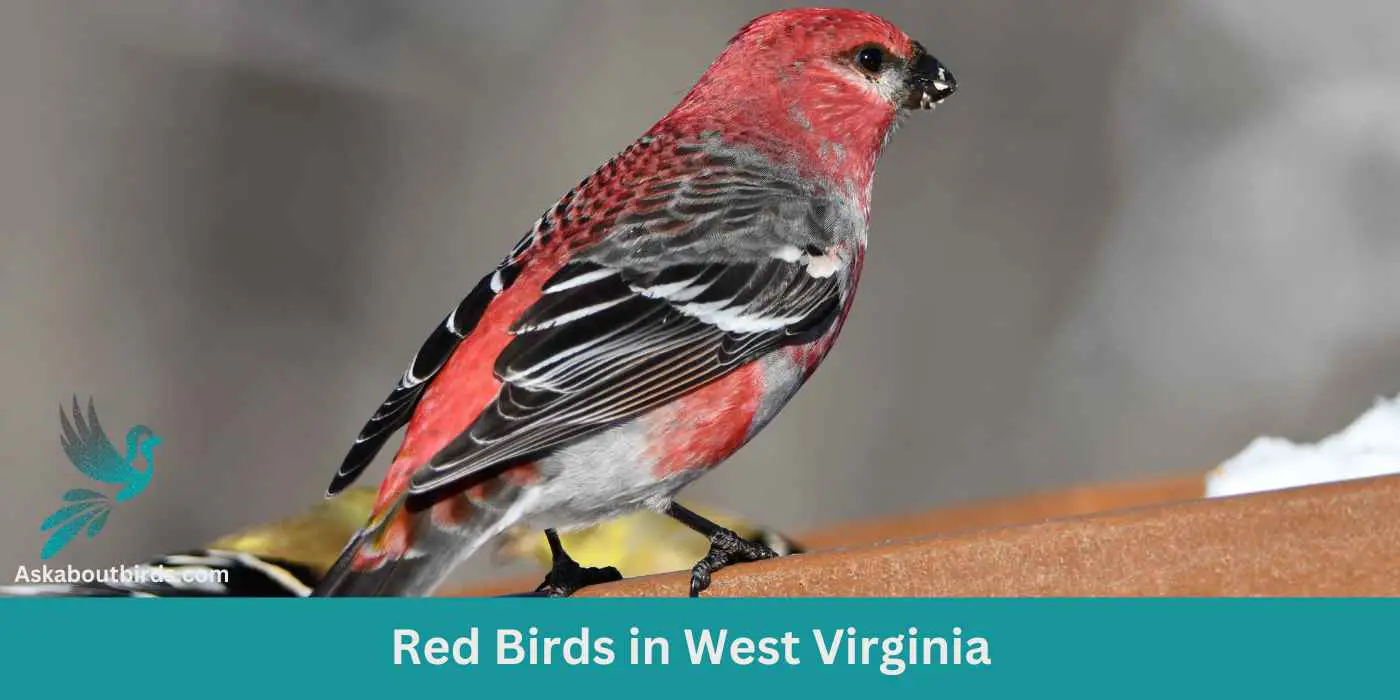West Virginia, often termed the “Mountain State,” is dominated by the rugged terrain of the Appalachian Mountains. It is a treasure trove for bird enthusiasts. Its diverse habitats and lush forests make it a sanctuary for various avian species, especially those adorned in striking shades of red.
Our curated list of 11 resplendent red birds, found exclusively in this state, offers both novices and seasoned birdwatchers a glimpse into this feathered world. Dive in and let these red-winged wonders captivate your heart.
Red Birds Found In West Virginia
West Virginia’s diverse topography of thick forests, rippling streams, and varied elevations creates a patchwork of microhabitats. This mosaic of environments supports a rich biodiversity, drawing a wide array of bird species.
The state’s geographical location also makes it a crucial migratory pathway, welcoming birds from both the northern and southern regions during different seasons.
Northern Cardinal


| Feature | Measurement |
|---|---|
| Scientific Name | Cardinalis cardinalis |
| Length | 8.3 – 9.1 in |
| Wingspan | 9.8 – 12.2 in |
| Weight | 1.19 – 2.29 oz |
The Northern Cardinal is an iconic North American bird, easily recognized by its vibrant color and melodious song.
Appearance: Male Northern Cardinals are a brilliant scarlet red, while females display a more subdued reddish olive. Both sexes have a distinctive black ‘mask’ on their face around the bill and a pointed crest on their head. The bird’s beak is robust, cone-shaped, and bright orange in color.
Diet: Northern Cardinals are primarily granivorous, with a diet largely consisting of seeds and grains. They also eat fruits and insects. These birds typically feed off the ground and are frequent visitors to bird feeders.
Reproduction: Northern Cardinals are monogamous, and a pair will breed together for life. The female typically builds a well-hidden nest in a dense thicket or shrub. She lays 2-5 eggs per clutch, which she incubates for around two weeks.
Red-Winged Blackbird
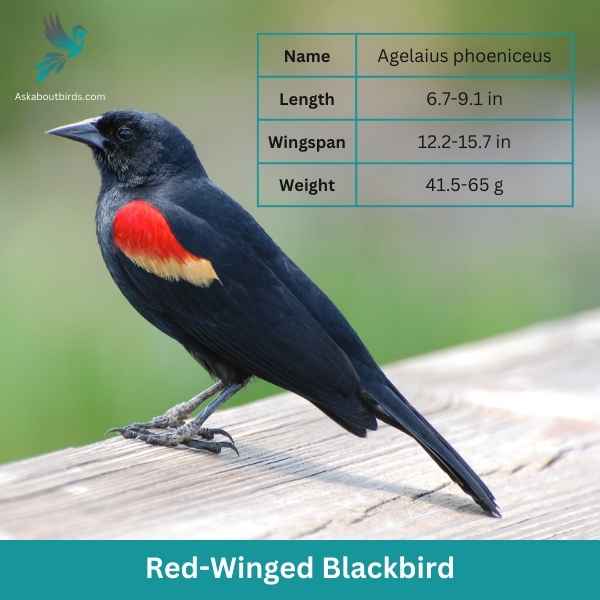
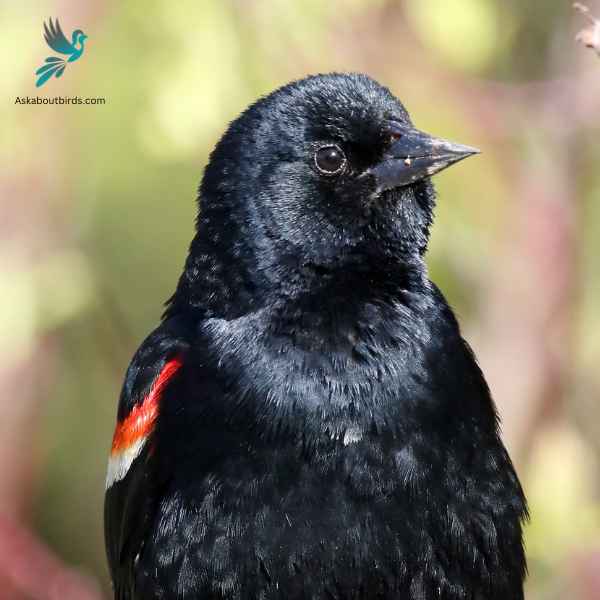
| Feature | Measurement |
|---|---|
| Scientific Name | Agelaius phoeniceus |
| Length | 6.7-9.1 in |
| Wingspan | 12.2-15.7 in |
| Weight | 41.5-65 g |
The Red-Winged Blackbird is a familiar sight across North America, especially in wetlands and open areas. Known for its striking coloration and distinct call, it is often seen perched on cattails or utility lines.
Appearance: Male Red-Winged Blackbirds are glossy black with bright red-and-yellow shoulder patches, while females are streaky brown, resembling a large sparrow. The males’ red patches become more prominent when they’re displaying or agitated.
Diet: Red-Winged Blackbirds primarily feed on seeds and insects. Their diet includes grains, sunflower seeds, and corn, but they also eat beetles, caterpillars, and other small invertebrates, especially in the breeding season.
Reproduction: Red-Winged Blackbirds nest in marshes, along watercourses, and in wet fields. The female constructs a cup-shaped nest using grass and sedge, attaching it to plants above water. She typically lays a clutch of 3 to 4 blue-green eggs, which she incubates for about 11-12 days. Males, being polygynous, often have multiple mates during a single breeding season.
Summer Tanager


| Feature | Measurement |
|---|---|
| Scientific Name | Piranga rubra |
| Length | 6.7 in |
| Wingspan | 28 to 30 cm |
| Weight | 29 g |
The Summer Tanager is a medium-sized songbird admired for its radiant plumage and melodious song.
Appearance: Male Summer Tanagers are an impressive bright red, while females and juveniles present a softer, yellow-orange color. Both genders have a large, slightly hooked bill and relatively short tail.
Diet: Summer Tanagers primarily feed on insects, including bees and wasps, which they catch in flight or pick off vegetation. They are also known to eat fruits and berries, making them helpful in controlling pest populations and seed dispersal.
Reproduction: The female Summer Tanager builds a loose, shallow cup-shaped nest out of twigs and grass, usually hidden in the foliage of trees. The female typically lays 3-5 eggs, which she will incubate for about two weeks.
Scarlet Tanager


| Feature | Measurement |
|---|---|
| Scientific Name | Piranga olivacea |
| Length | 6.3 to 7.5 in |
| Wingspan | 9.8 to 11.8 in |
| Weight | 23.5 to 38 g |
The Scarlet Tanager is a strikingly colorful bird known for its brilliant plumage and distinctive song.
Appearance: Male Scarlet Tanagers are notable for their vibrant scarlet bodies contrasted with black wings and tail, making them one of the most intensely colored birds. Females and juveniles, on the other hand, have a subdued olive-yellow body color with darker wings and tail.
Diet: The diet of the Scarlet Tanager is largely made up of insects, including beetles, cicadas, aphids, and others. They are adept flycatchers, seizing insects in mid-air or picking them off foliage. They also consume fruits and berries, especially during migration and in their winter habitats.
Reproduction: The female Scarlet Tanager builds a cup-shaped nest using twigs, rootlets, and grass, typically well-hidden in the dense foliage of trees. She lays 3 to 5 eggs and incubates them for about two weeks.
Red-headed Woodpecker

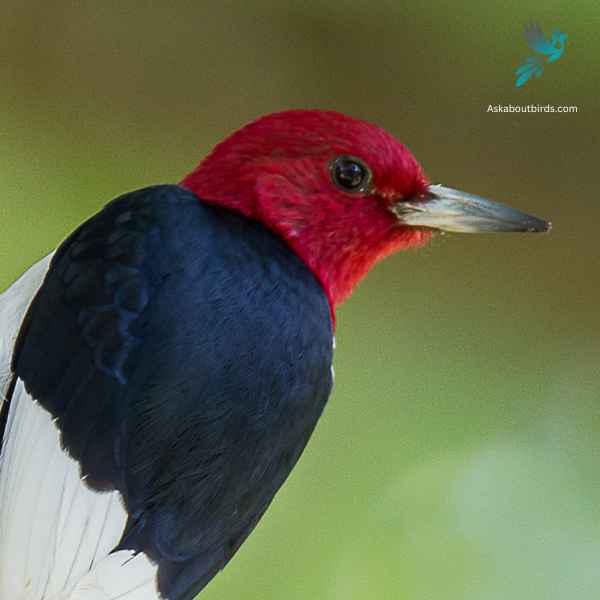
| Feature | Measurement |
|---|---|
| Scientific Name | Melanerpes erythrocephalus |
| Length | 7.5–9.1 in |
| Wingspan | 16.5 in |
| Weight | 2.0–3.2 oz |
The Red-headed Woodpecker is a striking forest bird with a bold tri-colored pattern.
Appearance: This woodpecker features a completely red head and neck, contrasting starkly with its white underparts and black wings. Its wings also have large white patches which are conspicuous in flight.
Diet: Red-headed Woodpeckers have a varied diet including insects, seeds, fruits, berries, and occasionally even the eggs of other birds. They’re also known to store food by wedging it into crevices in bark.
Reproduction: These woodpeckers nest in cavities which they excavate in dead wood or dead parts of live trees. These cavities can be found anywhere from 2 to 80 feet off the ground.
House Finch


| Feature | Measurement |
|---|---|
| Scientific Name | Haemorhous mexicanus |
| Length | 5–6 in |
| Wingspan | 8–10 in |
| Weight | 0.6–0.9 oz |
The House Finch is a small songbird widely distributed across North America and is commonly found in urban and suburban areas.
Appearance: Males of this species are brightly colored with crimson faces and throats, which can extend to the chest and back, while their flanks have streaks. The female is streaked brown and lacks the red coloring. Both have a square-tipped tail and a distinctively long, flat-topped bill.
Diet: House Finches primarily eat seeds, grains, and berries. They have a particular fondness for sunflower seeds and can be commonly seen at bird feeders. Occasionally, they will also consume insects, especially during the breeding season.
Reproduction: House Finches are cavity-nesters and might choose ledges, vents, ledges, and other urban settings. They might also utilize trees or shrubs. Their nests can be made of a wide array of materials, from feathers to twigs.
Purple Finch


| Feature | Measurement |
|---|---|
| Scientific Name | Haemorhous purpureus |
| Length | 4.7–6.3 in |
| Wingspan | 4.7–6.3 in |
| Weight | 0.6–1.1 oz |
The Purple Finch is a vibrant songbird often mistaken for its close relative, the House Finch, but it exhibits a different hue and patterns.
Appearance: Males are raspberry red on the head, throat, and breast, with streaky brown backs and wings. The intensity of the red can vary among individuals. Females are brown and streaked all over but might show a slight blush on the face. They lack the strong facial patterns seen in female House Finches.
Diet: Purple Finches primarily consume seeds, with a preference for sunflower seeds, dandelion seeds, and buds. They also eat insects and berries, especially during the breeding season.
Reproduction: These finches often nest in conifers or mixed woodlands. The nest, typically located on a horizontal branch, is made from twigs and grass, then lined with feathers.
Pine Grosbeak

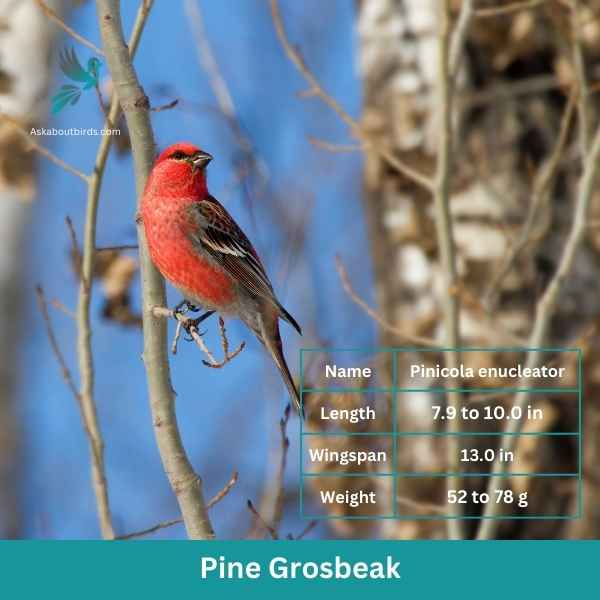
| Feature | Measurement |
|---|---|
| Scientific Name | Pinicola enucleator |
| Length | 7.9 to 10.0 in |
| Wingspan | 13.0 in |
| Weight | 52 to 78 g |
The Pine Grosbeak is a striking bird native to the northern regions of North America, often found in coniferous forests. Both males and females have a plump and robust body with a large beak adapted for eating seeds. The male Pine Grosbeak displays a vibrant reddish-pink plumage, while the female has a more subdued grayish-brown coloration.
These birds are typically seen in small flocks, foraging for food in trees and on the ground. They have a preference for seeds, particularly those from various conifer species. The Pine Grosbeak uses its strong bill to crack open the cones of tall trees and extract the seeds, but they also consume berries and small fruits when available.
Red Crossbill

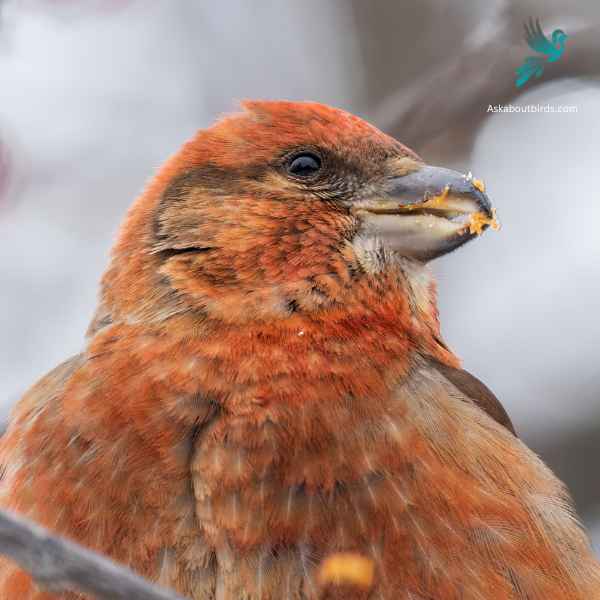
| Feature | Measurement |
|---|---|
| Scientific Name | Loxia curvirostra |
| Length | 5.5–7.5 in |
| Wingspan | 9.8–10.6 in |
| Weight | 0.9–1.4 oz |
The Red Crossbill is a distinctive finch known for its unusual bill, which has evolved to extract seeds from conifer cones.
Appearance: Males are typically bright red or orange, while females are greenish-yellow or olive. Both genders have the characteristic crossed bill, which they use to expertly extract seeds from tightly closed conifer cones.
Diet: Red Crossbills primarily feed on the seeds of coniferous trees, such as spruce, pine, and fir. Their specialized bills allow them to efficiently pry apart conifer cone scales to access the seeds.
Reproduction: Red Crossbills are somewhat nomadic and don’t adhere to a strict breeding schedule. Instead, they breed whenever and wherever food is abundant. Their nests are usually built on horizontal branches of conifer trees.
Rose-breasted Grosbeak
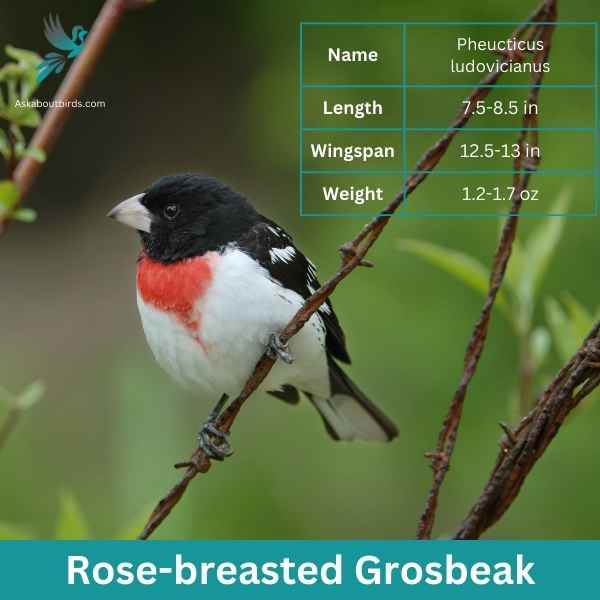

| Feature | Measurement |
|---|---|
| Scientific Name | Pheucticus ludovicianus |
| Length | 7.5-8.5 in |
| Wingspan | 12.5-13 in |
| Weight | 1.2-1.7 oz |
The Rose-breasted Grosbeak is a songbird of medium size, widely recognized for its vibrant coloration and melodious song.
Appearance: Male Rose-breasted Grosbeaks boast a striking contrast with black and white plumage accompanied by a radiant rose-colored patch on the chest and under the wings. In contrast, females exhibit streaked brown and white plumage, resembling large sparrows but with a thick bill.
Diet: The diet of the Rose-breasted Grosbeak consists of a mixture of seeds, insects, and fruits. During summer, they primarily feed on insects, while seeds and fruits become more prevalent in their diet during the colder months.
Reproduction: These birds build cup-shaped nests typically situated in trees or large shrubs. Both the male and female partake in incubation duties, ensuring the eggs’ safety and warmth. After hatching, the chicks are primarily fed insects.
Red-bellied Woodpecker
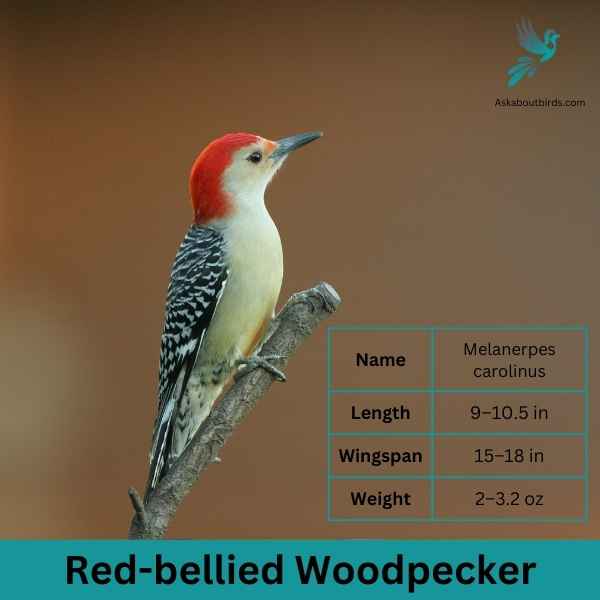
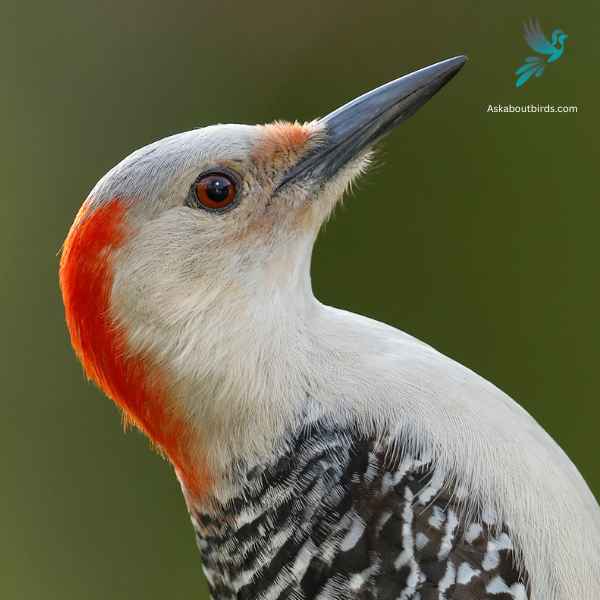
| Feature | Measurement |
|---|---|
| Scientific Name | Thryothorus ludovicianus |
| Length | 4.7–5.5 in |
| Wingspan | 11 in |
| Weight | 0.63–0.81 oz |
The Red-bellied Woodpecker is a medium-sized woodpecker commonly found in woodlands, forests, and backyards across the eastern and central U.S.
Appearance: The Red-bellied Woodpecker sports a pale gray face, throat, and belly, contrasted by a zebra-striped back. Its name derives from the subtle reddish tinge on its belly, but it’s more commonly recognized by the vivid red cap on the head of males and the partial red cap on females.
Diet: This woodpecker has a varied diet that includes insects, fruits, nuts, and seeds. They frequently forage on tree trunks and branches, using their sticky, barbed-tipped tongue to extract ants, beetles, and other insects from crevices.
Reproduction: Red-bellied Woodpeckers are cavity nesters, excavating holes in tree trunks for their nests. The inside of the nest is typically unlined or sparingly lined with wood chips.
Where to Spot West Virginia’s Red Birds
West Virginia, with its undulating terrains and dense woodlands, offers some of the nation’s prime locations for bird enthusiasts. Here are the top spots where the diversity of our feathered friends truly shines:
- New River Gorge National Park and Preserve: A paradise for birdwatchers, this expansive area showcases species from raptors to songbirds. The varying elevations and dense forests create an ideal habitat for numerous birds, making it a must-visit.
- Canaan Valley National Wildlife Refuge: Positioned in a high-altitude wetland, it’s a haven for waterfowl and migratory birds. Its unique ecosystem ensures sightings of some of the rarest bird species in the state.
- Dolly Sods Wilderness: This high-altitude plateau offers a mix of bogs, heaths, and forests. The diverse landscape here attracts a wide range of birds, from warblers to hawks.
- Cranberry Glades Botanical Area: Renowned for its northern-hardwood and boreal-type plants, this area also provides a habitat for numerous bird species. Its unique plant life attracts a variety of insects, making it a hotspot for insectivorous birds.
- Monongahela National Forest: Spanning over 900,000 acres, this forested area is home to over 230 species of birds. Its vastness and varied landscapes ensure a rewarding birdwatching experience throughout the year.
| State’s Red Birds | Top Spots for Red Birds |
|---|---|
| Kentucky’s Red birds | 1. Daniel Boone National Forest 2. Red River Gorge Geological Area 3. Mammoth Cave National Park |
| Maryland’s Red birds | 1. Blackwater National Wildlife Refuge 2. Assateague Island National Seashore 3. Catoctin Mountain Park |
| Ohio’s Red birds | 1. Cuyahoga Valley National Park 2. Magee Marsh Wildlife Area 3. Shawnee State Forest |
| Pennsylvania’s Red birds | 1. Hawk Mountain Sanctuary 2. Allegheny National Forest 3. Presque Isle State Park |
| Virginia’s Red birds | 1. Shenandoah National Park 2. Great Dismal Swamp National Wildlife Refuge 3. Chincoteague National Wildlife Refuge |
FAQs on Red Bird Species Found in West Virginia
Why are white winged crossbills sought after by birdwatchers during the winter season?
White winged crossbills, distinguishable by their two white wing bars, are predominantly a northern and western states species. Their strong association with conifer seeds, particularly pine cones, makes them frequent visitors of spruce trees during the winter season. Their striking red plumage and unique feeding habits set against the backdrop of snowy forest canopy make them a captivating sight. For birdwatchers, especially those with backyard feeders stocked with black oil sunflower seeds, spotting this medium-sized bird can be a highlight on their winter checklist.
What differentiates the ruby throated hummingbird from other hummingbirds?
The ruby throated hummingbird, predominantly found in central and south America, is a standout species primarily because of its vibrant red plumage complemented by green wings and a pale bill. Their distinctive appearance, combined with their fast-paced hovering around flower beds and shade trees, makes them an easy identification for bird enthusiasts. During migration, they often venture into the southern and eastern states, and their presence can be a significant tick on summer and winter checklists for birdwatchers.
How does the painted bunting’s appearance set it apart?
The painted bunting, with its spectacular bright red plumage complemented by green wings, is an eye-catching bird native to central and south America. It’s often dubbed as one of the most beautiful birds of North America. Though medium in size, its vibrant colors, especially when perched against the forest canopy or forest edges, make it immensely popular among birdwatchers. The sight of one visiting backyard feeders, especially if stocked with black oil sunflower seeds, is indeed a treat.
Why are black oil sunflower seeds popular in backyard feeders?
Black oil sunflower seeds are a top choice for many bird species, making them immensely popular in backyard feeders. Birds like the white winged crossbill and the painted bunting are particularly drawn to these seeds. The high oil content provides essential fats beneficial during colder winter months, especially in the northern and western states. Their universal appeal attracts a diverse range of birds, ensuring year-round avian activity and enhancing birdwatching experiences for homeowners.

